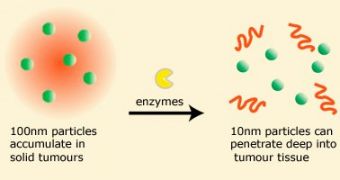The fight against tumors makes progress every day, and now, a team of scientists from the Massachusetts Institute of Technology (MIT) and Harvard Medical School in the US, created a nanoparticle that breaks up in smaller units after reaching its target, allowing a better tumor tissue penetration and a more efficient treatment.
Who would’ve thought that nanoparticles were too 'large' to pass deep into the tightly packed tissue of tumors?
And still, this is one of the main reasons for which nanoparticle therapy against cancer shows modest benefits, even with all the effort put into it.
This new solution uses a system that works on the same principle as a disintegrating fruit jelly – researcher Dai Fukumura explains:
“The blood vessels of tumor cells are leaky, in other words they have bigger pores for macromolecules to get through [compared to healthy cells].
“So if you have 100nm size particles they will discriminate mainly for tumor cells and that is why people think nanoparticles will be so good for cancer treatment.”
But it seems that once the 100nm particles reach their target, they are too big to travel inside the dense tissue of the tumor, so it was necessary for the scientists to develop a proof of principle gel nanoparticles that overcomes this problem.
The new nanoparticles are basically 100nm balls of gelatine, containing smaller particles of only 10nm in diameter, so when they get to the tumor, the tumor enzymes digest the gelatine and release the smaller components.
For now, the new method has been tested in vitro and the results showed that the particles penetrated the tumor much better, RSC reports.
However, Paul Borm, a nanoparticle medicine specialist at Zuyd University in the Netherlands, is not convinced that these smaller nanoparticles will work as well once they will carry a drug.
Fukumura, replied that for now, their research showed that this approach is a valid one, and that they will continue to optimize the transport of the small nanoparticles through the tumor tissue, by looking for the most effective size, charge and surface chemistry.

 14 DAY TRIAL //
14 DAY TRIAL //